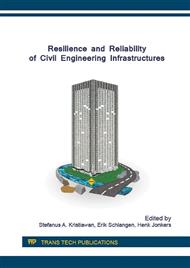p.154
p.158
p.166
p.175
p.181
p.188
p.193
p.202
p.208
Strengthening and Retrofitting Strategy for Masonry (New Build Construction in Indonesia)
Abstract:
In Indonesia, number of non-engineered structures have significantly been found which the houses were built by unskilled workers using masonry either unconfined or confined. The non-engineered housing units developed in urban region are also vulnerable to seismic hazard due to the use of low quality of material and constructions method. Those structures are not resistant to extreme lateral loads and their failure during an earthquake can lead to significant loss of life. This paper is concerned with the structural performance of Indonesian low-rise buildings made of masonry under lateral seismic load. Experimental testing of masonry has been carried out in Indonesia to establish the quality of materials and to provide material properties for numerical simulations. The results found that the strength of Indonesia-Bali clay brick masonry are below the minimum standard required for masonry structures built in seismic regions, being at least 50% lower than the requirement specified in British Standard and Eurocode-6 (BS EN 1996-1-1:2005). In general, structural tests under monotonic and cyclic loading have been conducted to determine the load-displacement capacity of local hand-made masonry wall panels in order to: (1) evaluate the performance of masonry structure, (2) investigate the dynamic behaviour of the structure, and (3) observe the effect of in-plane stiffness and ductility level. Detailed numerical models of the experimental specimens were simulated in Abaqus using three-dimensional solid elements. Cohesive elements were used to simulate the mortar behaviour, exhibiting cracking and the associated physical separation of the elements. A range of available material plasticity models were reviewed: Drucker-Prager, Crystalline Plasticity, and Cohesive Damage model. It was found that the combination of Crystalline Plasticity model for the brick unit and the Cohesive Damage model for the mortar is capable of simulating the experimental load-displacement behavour fairly accurately. The validated numerical models have been used to (1) predict the lateral load capacity, (2) determine the cracking load and patterns, (3) carry out a detailed parametric study by changing the geometric and material properties different to the experimental specimens. The numerical models were used to assess different strengthening measures such as using bamboo as reinforcement in the masonry walls which the performance of wall found to be better
Info:
Periodical:
Pages:
181-187
Citation:
Online since:
July 2016
Authors:
Price:
Сopyright:
© 2016 Trans Tech Publications Ltd. All Rights Reserved
Share:
Citation:


